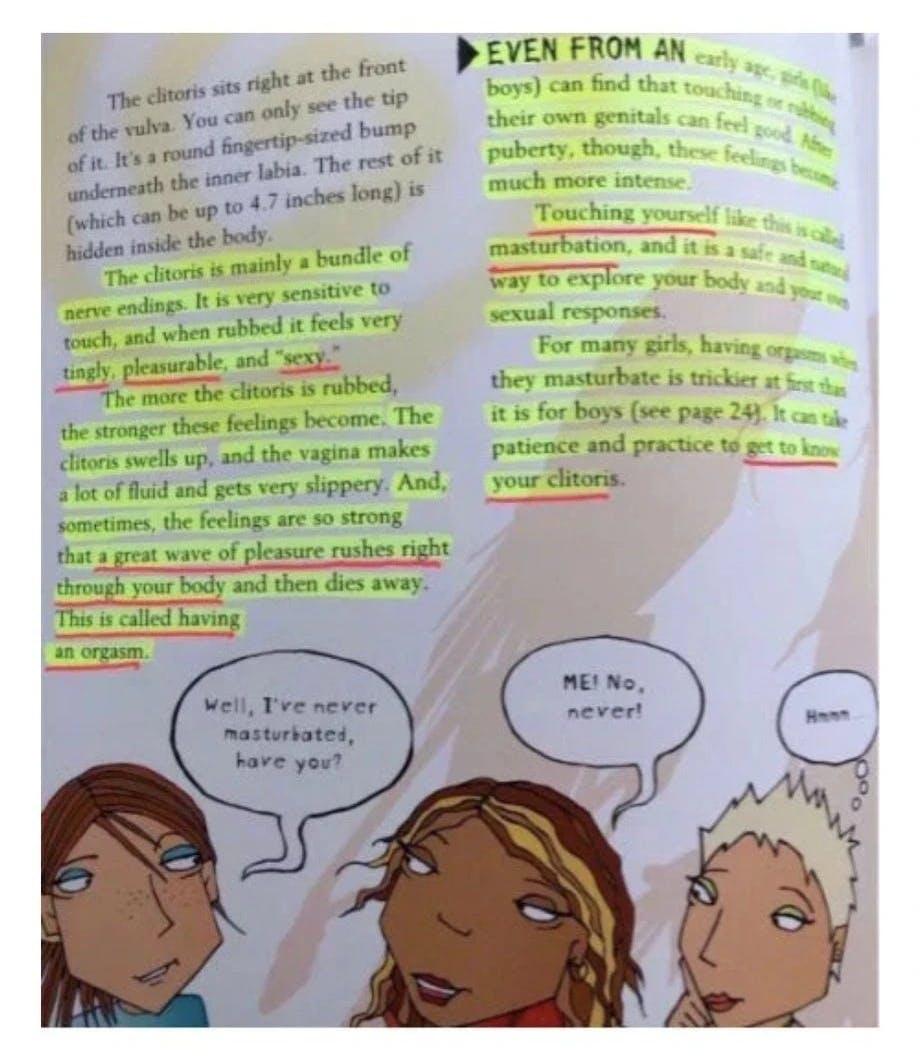Sexually Explicit Curriculum Now Begins As Early As Kindergarten In California's Public Schools
In 2019, California education officials decided that a new, more comprehensive sexual education curriculum was needed for students – beginning in kindergarten.

The content includes “gender-neutral and LGBTQ-inclusive language, material on consent and sex-trafficking and the continued teaching of HIV prevention.”
Children are Learning about Sexuality in Graphic Detail
The following screenshot comes from part of the 5th grade curriculum, where students are educated on the clitoris, orgasms, and the process of masturbation. Students are told that “even from a young age girls and boys can find touching themselves to feel very good” and that “touching yourself is a safe way to explore your own body.” Young girls are encouraged “not to give up” if they don’t immediately have orgasms, and that “it can take practice and patience to get to know your clitoris.”

In addition to the foundational curriculum, other books that were discussed as resources included titles like “S.E.X.: The All-You-Need-to-Know Sexuality Guide to Get You Through Your Teens and Twenties, which includes descriptions of anal sex and bondage; and “Changing You,” which includes cartoon illustrations of female and male genitalia.” Creators and proponents of the programs say that “life has become exponentially more complex in the last few decades” and that this type of education is necessary for the total physical and emotional wellbeing of students as young as 5.
Creators say this education is necessary for the total physical and emotional wellbeing of students as young as 5.
They argue that the information specifically regarding LGBTQ inclusion is necessary because the goal is for “families to have age-appropriate, medically accurate information to make their own choices for their health.” These resources detail that “gender is more than the body you are born with” and includes more than 840 references to the words sex/sexual/sexuality in the K-12 curriculum framework.
The question then becomes whether these lessons actually achieve the goal of providing “medically accurate information,” not to mention whether or not they're remotely relevant to the general objectives of education in classrooms as young as kindergarten.
The “Choice” Parents Have
While parents can opt out of the actual sex education classes, materials and resources are still available for use by teachers and districts in all areas of content and curriculum, so simply opting out by no means guarantees that a student will be shielded from the information. Although the law states that material must be “age-appropriate” and “objective,” it also states that materials “affirmatively recognize different sexual orientations and be inclusive of same-sex relationships in discussions, teach about gender, gender expression, and gender identity.”
Critics argue that by nature these topics are hardly “objective,” and petitions and complaints have been raised since the introduction of these ideas and curriculums.
While parents can opt out of the actual sex education classes, materials are still available for use by teachers.
Those who believe these programs are necessary argue that these lessons are valuable for students who may be experiencing types of gender confusion and are even more important for students who aren’t but need to learn how to be accepting and inclusive. Concerned parents argue that the material is harmful, biased, and certainly not age-appropriate.
Closing Thoughts: The Real Issue
The fundamental issue here that's less discussed is whether or not it's the job of publicly-funded schools to adopt and implement these types of teaching. If there is a medical necessity to learn this information, shouldn’t it be taught by doctors and others in the medical professional? Whether or not this is appropriate, truthful, and unbiased is certainly one facet of the debate. The other is the essential quandary of whose responsibility it is to impart this information. Should public funding be used to create and teach this type of material? Should this curriculum, beginning in kindergarten, take away from other facets of crucial classroom instruction? With each passing day, these questions are being discussed less and dismissed more in the name of health, safety, and inclusivity.